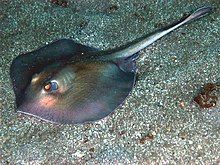
The Urolophidae are a family of rays in the order Myliobatiformes, commonly known as stingarees or round stingrays. This family formerly included the genera Urobatis and Urotrygon of the Americas, which are presently recognized as forming their own family Urotrygonidae. Stingarees are found in the Indo-Pacific region, with the greatest diversity off Australia. They are sluggish, bottom-dwelling fish that have been recorded from shallow waters close to shore to deep waters over the upper continental slope. Measuring between 15 and 80 cm long, these rays have oval to diamond-shaped pectoral fin discs and relatively short tails that terminate in leaf-shaped caudal fins, and may also have small dorsal fins and lateral skin folds. Most are smooth-skinned, and some have ornate dorsal color patterns.

The bala shark also known as the tricolor shark, tricolor sharkminnow, silver shark, or shark minnow, is a fish of the family Cyprinidae, and is one of the two species in the genus Balantiocheilos. This species is not a true shark, but is commonly so called because of its torpedo-shaped body and large fins.
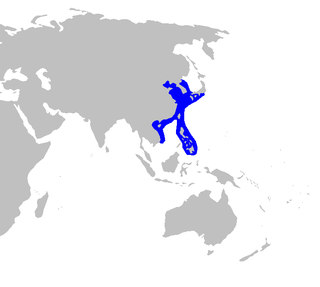
The Japanese spurdog is a dogfish, a member of the family Squalidae. It is found in the western Pacific Ocean – southeastern Japan and the East China Sea, including the Republic of Korea, the Philippines, and the Arafura Sea.
The coastal stingaree is an uncommon species of round ray in the stingaree family, Urolophidae, that is endemic to the eastern Great Australian Bight.

Cristiceps aurantiacus is a species of clinid found around New South Wales, Australia and New Zealand. It lives in tide pools and the subtidal zone to a depth of 30 metres (98 ft). Its diet consists of crustaceans and small fishes. It can reach a length of 22 centimetres (8.7 in) TL.
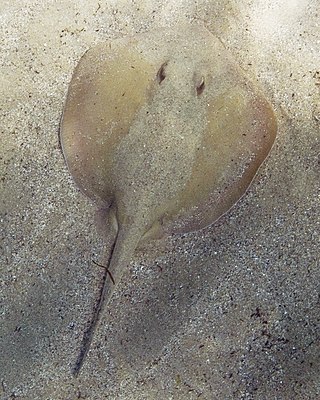
The common stingaree is a species of stingray in the family Urolophidae. The most abundant ray in inshore waters off eastern Australia, it generally inhabits estuaries, sandy flats, and rocky reefs from the shore to a depth of 60 m (200 ft). This plain brownish to grayish species has a rounded pectoral fin disc with a broadly triangular snout. Its nostrils have enlarged lobes on their outer margins and a skirt-shaped curtain of skin with a fringed posterior margin between them. Its tail bears a small dorsal fin before the stinging spine, and terminates in a leaf-shaped caudal fin. This ray can grow to 52 cm (20 in) long.

Urolophus is a genus of round rays mostly native to the western Pacific Ocean and the Indian Ocean, though one species occurs in the Pacific waters of the Mexican coast. Müller and Henle erected Urolophus in an 1837 issue of Bericht Akademie der Wissenschaften zu Berlin. The name is derived from the Greek oura, meaning "tail", and lophos, meaning "crest". In Urolophus, the outer rims of the nostrils are not enlarged into lobes, but may form a small knob at the back.

The crossback stingaree or banded stingaree is a species of stingray in the family Urolophidae. It is endemic to southeastern Australia, mainly off Victoria and Tasmania but also marginally to New South Wales and South Australia. This bottom-dwelling fish generally inhabits sand and reef habitats deeper than 100 m (330 ft) off Victoria, and muddy habitats in shallow bays and estuaries off Tasmania. Befitting its name, the crossback stingaree has a distinctive dark pattern on its back, consisting of a midline stripe that is crossed by three transverse bars. It has an oval pectoral fin disc with a blunt snout and a skirt-shaped curtain of skin between the nostrils. Its tail is short with no skin fold along the sides, and a deep, leaf-shaped caudal fin. The youngest rays may have a small dorsal fin in front of the stinging tail spine. This species reaches 50 cm (20 in) in length.
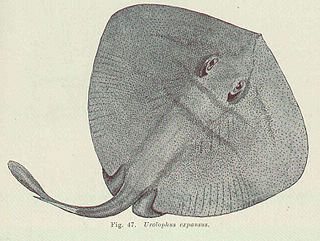
The wide stingaree is a little-known species of stingray in the family Urolophidae, found off southwestern Australia. It typically occurs over sand in water 200–300 m (660–980 ft) deep around the edge of the continental shelf. This species has a broad diamond-shaped pectoral fin disc, a slightly pointed snout, and a tail with a leaf-like caudal fin, skin folds along either side, and no dorsal fins. Between its nostrils is a skirt-shaped curtain of skin. It is grayish green above, with faint bluish lines beside and behind the eyes. The maximum length on record is 52 cm (20 in).

The spotted stingaree is an uncommon species of stingray in the family Urolophidae, endemic to shallow waters along the coast of southern Australia. It favors rocky reefs and seagrass beds. This species can be readily identified by its nearly circular, dark-colored pectoral fin disc, adorned with a complex pattern of white or cream spots. Its eastern and western forms differ slightly in coloration and have been regarded as separate species. There is a skirt-shaped curtain of skin between its nostrils. Its tail is fairly thick and terminates in a short leaf-shaped caudal fin; a relatively large dorsal fin is present just in front of the stinging spine.
The Kai stingaree is a species of stingray in the family Urolophidae, known only from two juveniles collected from 236 m (774 ft) deep in the Kai Islands of eastern Indonesia. This species has a rhomboid pectoral fin with a very blunt, rounded snout, and a tail with lateral skin folds, a leaf-shaped caudal fin, and no dorsal fin. It is brown above with blackish coloring on the upper surface of each eyeball. The larger of the two specimens measures 23 cm (9.1 in) long. The International Union for Conservation of Nature (IUCN) does not yet have enough information to assess the Kai stingaree beyond Data Deficient. It presently faces little fishing, though this is liable to change in the future.

The Kapala stingaree is a species of stingray in the family Urolophidae, endemic to inshore waters off southeastern Queensland and New South Wales. It is commonly found on and around rocky reefs at a depth of 10–130 m (33–427 ft). Reaching 51 cm (20 in) in length, the Kapala stingaree has a rounded, diamond-shaped pectoral fin disc and a slender tail, which ends in a leaf-shaped caudal fin and bears lateral skin folds and a small dorsal fin in front of the stinging spine. It has a distinctive bell-shaped curtain of skin between its nostrils. This species is greenish above, with a highly variable pattern of dark markings usually found outside and between the eyes, and over the back and tail.
The yellowback stingaree is a locally abundant but little-known species of stingray in the family Urolophidae. It is almost endemic to New South Wales, with a range from Green Cape northward, extending only barely into Queensland. It inhabits soft-substrate habitats and has been reported from depths of 45–300 metres (150–980 ft), though it is most common on the outer continental shelf at depths of 100–160 metres (330–520 ft).
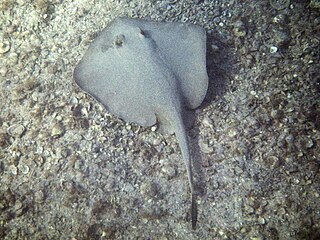
The greenback stingaree is a little-known species of stingray in the family Urolophidae, endemic to the outer continental shelf and upper continental slope off southeastern Australia. Growing to a length of 51 cm (20 in), this species has a diamond-shaped pectoral fin disc wider than long and uniformly light green in color above. Between its nostrils is a skirt-shaped curtain of skin. Its tail bears skin folds on either side and a deep, lanceolate caudal fin, but lacks a dorsal fin.
The brown stingaree is a little-known species of stingray in the family Urolophidae, found at a depth of 60–220 m (200–720 ft) on the outer continental shelf off northern Western Australia. This species has a rhomboid pectoral fin disc colored light yellow or brown, sometimes with three faint, darker, transverse bars. Its nostrils have a skirt-shaped curtain of skin between them. Its tail ends in a leaf-shaped caudal fin and either lacks or has poorly developed lateral skin folds and a dorsal fin. The maximum known length is 36 cm (14 in). The International Union for Conservation of Nature (IUCN) has listed the brown stingaree under Least Concern, as there is negligible fishing pressure across most of its range.
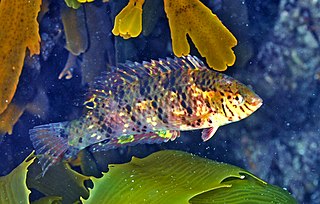
Dotalabrus aurantiacus, Castelnau's wrasse, is a species of wrasses native to the Indian Ocean coasts of Australia. It is the type species of its genus. The type locality is Adelaide, St. Vincent Gulf, South Australia.
Phenacogrammus aurantiacus is a species of freshwater fish in the African tetra family. Individuals of the species may reach a length of 10.0 cm (3.9 in). The fish has silvery sides with a central broad dark band that starts just behind the gills and runs to the caudal fin. The colour of the band varies greatly in intensity between individuals of the species.
